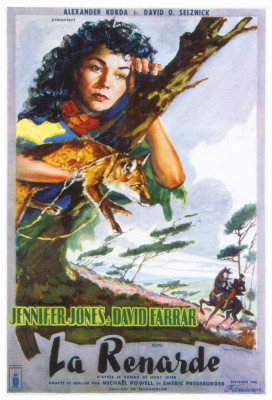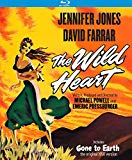| Reviews & Columns |
|
Reviews DVD TV on DVD Blu-ray 4K UHD International DVDs In Theaters Reviews by Studio Video Games Features Collector Series DVDs Easter Egg Database Interviews DVD Talk Radio Feature Articles Columns Anime Talk DVD Savant Horror DVDs The M.O.D. Squad Art House HD Talk Silent DVD
|
DVD Talk Forum |
|
|
| Resources |
|
DVD Price Search Customer Service #'s RCE Info Links |
|
Columns
|
|
|
Wild Heart / Gone to Earth, The
So, if you're watching this film for the first time, let me state it again: View Gone to Earth first. Save The Wild Heart for another time.
Powell and Pressburger, who under the name The Archers produced, wrote, and directed two dozen films together, mostly throughout the ‘40s and ‘50s, were one of a kind artists. Their movies don't resemble those of any other filmmakers; some don't even resemble other Powell-Pressburger films. Their movies either completely subvert genre norms or, as in the case of Gone to Earth, aren't particularly classifiable at all. Their best movies are artful as all get-out yet they're not really pretentious: they're rich like French food yet accessible to everyday audiences. Many are playful and fanciful and whether filmed in color or black-and-white (or both), they are always gorgeous to look at, with outstanding cinematography and production design, overwhelming in their beauty. Even their World War II naval epic, The Battle of the River Plate (1956), set mostly on and below warship decks, is visually stunning, standing far apart from other films of that type.
Selznick's involvement as a co-producer, which consisted mainly of providing the services of his actress-wife, star Jennifer Jones, didn't impact the Archers' methods or the film's production and release in the UK all that much, but he pretty much sabotaged the movie for its release in the U.S., a process that delayed the U.S. release by nearly two years.
Set in late-1890s Shropshire, near the English-Welsh border, the story concerns Hazel (Jennifer Jones), the bare-footed, superstitious, and backwoods daughter of widower Abel Woodus (Esmond Knight), who ekes out a living making coffins, repairing harps, raising bees, and other odd jobs.
Born of a gypsy mother, Hazel is a carefree child of nature, raising a wild fox cub, Foxy, and who possesses a Tarzan-like affinity with and affection for the local animals. Her raw if unkempt beauty attracts the obsessive attentions of Jack Reddin (David Farrar), a squire living in a decaying mansion with manservant Vessons (Hugh Griffith). Jack's brusque attempts to ravage Hazel send her fleeing, and instead she becomes engaged to newly arrived Baptist minister Edward Marston (Cyril Cusack), he unconcerned that Hazel is far beneath his social class. She appreciates his gentle nature, especially toward Foxy, but remains attracted to the more dangerous Jack.
Hazel, then, finds herself trapped between two extremes in men: a kind minister so in awe of her innate innocence that he's unable to have sex with her, even after they're married; and the other a rotter oozing with vices yet full of passion.
Jack Cardiff, the great cinematographer of Powell and Pressburger's A Matter of Life and Death (1946), Black Narcissus (1947), and The Red Shoes (1948), had moved onto other big films, shooting Hitchcock's Under Capricorn about the same time Gone to Earth was in production. The duo instead turned to Christopher Challis, whose three-strip Technicolor photography is similarly lush, the Shropshire countryside taking on the same ethereal qualities as that of its heroine. From what I can tell, it's a part of England infrequently used in British films; even many British audiences may have found the dialect (e.g., "Ah," for "Yes") and thick Welsh-like accents unfamiliar.
The unique beauty of and fine acting in Gone to Earth compensates viewers for its terribly dark and downbeat story; a feeling of dread hangs over nearly the entire movie. Though based on a popular Mary Webb novel, the project is anything but commercial. I'd gladly watch most of the Powell-Pressburger classics annually, but even die-fans of their films probably won't want to sit through Down to Earth more than once or twice, good as it is.
Jennifer Jones was a fine actress, but once David Selznick began his affair and eventually married her, his adulation clouded his judgement, much like the minister's in the film. Her roles under his suffocating control became misguided showcases. Gone to Earth is a rare exception, at least in its original form, playing to her strengths as an earthly, enigmatic natural beauty. Even her Shropshire accent plays well.
Undoubtedly Selznick disliked the Powell-Pressburger version partly because of the manner in which Jones is presented: dirty bare feet, disheveled hair, less makeup, etc., never realizing that those touches somehow make her look more alluring in the picture, not less. After a lengthy court battle Selznick discovered he could alter the U.S. release version any way he saw fit. The Wild Heart runs just 82 minutes - 86 minutes if one counts the roadshow version's overture and exit music, with more than a half-hour cut. (Surely no sound era roadshow had a shorter running time!)
Beyond ruining the deliberate pacing, jettisoning peripheral story and plot elements, with new inserts, including Joseph Cotten's unnecessary narration, the film becomes thuddingly literal. A critical location in the story, an abandoned mine shaft with a black, bottomless pit, carries much weight in the story as a symbol of death; what it means to the characters and the story is far more important than what it actually is. In Selznick's cut, he inserts cutaways to a sign reading (I paraphrase) "DANGER: Abandoned Mine!"
The inserts are, for the most part, impressively seamless, resembling outtakes more than retakes. Besides Jones, Selznick went to the trouble, for instance, of bringing David Farrar for some new shots, the actor opting to stay in Hollywood for most of the rest of the career, perhaps on promises from Selznick in exchange for his cooperation. However, where the original cuts make marvelous use of a trained fox Hazel cradles in her arms much of the time, in the retakes Jones is clearly hauling a moth-eaten stuffed fox, ruining the illusion.
Video & Audio
The main menu on the disc gives viewers the choice of either version, both of which appear drawn from composite negatives rather than directly from black-and-white separations. At times the image is outstanding, but optical effects and a few misaligned matrixes do rear their head here and there. It may not look as splendiferous as, say, the Blu-ray releases of Black Narcissus but the transfers are definitely in A-/B+ territory. The DTS-HD Master Audio 2.0 mono, in French only with optional English subtitles, is likewise very good. Region "A" encoded.
Extra Features
There's a commentary track for each version of the film: Troy Howarth on The Wild Heart and Samm Deighan on Gone to Earth. A big batch of Jennifer Jones trailers for movies also available through Kino is also included.
Parting Thoughts
Not exactly the crowd-pleaser that so many other Powell-Pressburger movies are, Gone to Earth is nevertheless nearly as great as their best pictures, and this disc is Highly Recommended.
Stuart Galbraith IV is the Kyoto-based film historian currently restoring a 200-year-old Japanese farmhouse.
|
| Popular Reviews |
| Sponsored Links |
|
|
| Sponsored Links |
|
|
| Release List | Reviews | Shop | Newsletter | Forum | DVD Giveaways | Blu-Ray | Advertise |
|
Copyright 2024 DVDTalk.com All Rights Reserved. Legal Info, Privacy Policy, Terms of Use,
Manage Preferences,
Your Privacy Choices | |||||||














